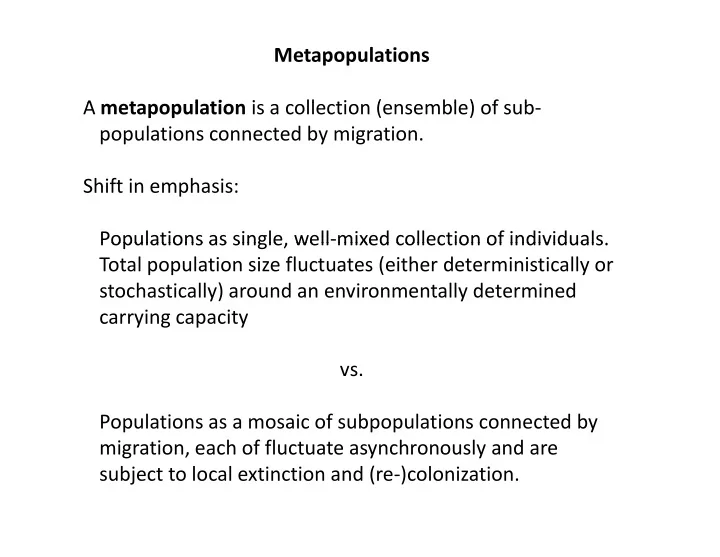

Metapopulations A A metapopulation is a collection (ensemble) of sub ‐ t l ti i ll ti ( bl ) f b populations connected by migration. Shift in emphasis: Populations as single, well ‐ mixed collection of individuals. Populations as single, well mixed collection of individuals. Total population size fluctuates (either deterministically or stochastically) around an environmentally determined carrying capacity i it vs. Populations as a mosaic of subpopulations connected by migration, each of fluctuate asynchronously and are migration, each of fluctuate asynchronously and are subject to local extinction and (re ‐ )colonization.
Metapopulations: examples Glanville fritillary fritillary (Ilkka Hanski, U. Helsinki) Image courtesy UK Butterflies
Metapopulations: examples Bay checkerspot butterfly (Susan Harrison UC Davis (Susan Harrison, UC Davis Paul Ehrlich, Stanford) “island mainland metapopulation” island ‐ mainland metapopulation Images courtesy Cal Academy
Hanski’s four “conditions” for metapopulations 1 1. The suitable habitat occurs in discrete patches which Th it bl h bit t i di t t h hi h may be occupied by local breeding populations. 2. All local populations have a substantial risk of extinction. 3. Habitat patches are not too isolated to prevent 3. Habitat patches are not too isolated to prevent recolonization. 4 4. Local populations do not have completely syncrhonous L l l ti d t h l t l h dynamics.
Richard Levins’s metapopulation model (1969) “th “the mother of all metapopulation models” (Hanski) th f ll t l ti d l ” (H ki) p = proportion of habitat patches that are occupied c = rate of propagule production, per occupied patch e = per patch rate of extinction dp dt cp (1 p ) ep
Key assumptions in the Levins model • No differences among patches N diff t h • No spatial structure (model is “implicitly spatial”) • Local population dynamics within a patch are unimportant (or happen quickly relative to the processes of colonization (or happen quickly relative to the processes of colonization and extinction). • Large number of patches L b f t h
Model variations Island – mainland model: “propagule rain” I l d i l d d l “ l i ” dp dt c (1 p ) ep
Model variations: rescue effect H Hanski: “One of the more frequently used but often ki “O f th f tl d b t ft misunderstood concepts in the metapopulation literature” Basic idea: => When p is large, some patches will have large local populations. populations. => Large local populations generate migrants that emigrate f from densely occupied patches to sparsely occupied d l i d t h t l i d patches.
Model variations: rescue effect, con’t => Migration to sparsely occupied patches decreases Mi ti t l i d t h d extinction at those patches. Reduction in extinction probability from immigration to sparsely occupied patches exceeds increase in extinction probability caused by emigration from emigration from densely occupied patches. (Think Allee effects.) patches. (Think Allee effects.) => Thus, per patch rate of extinction, e , decreases as p increases. d dp dt cp (1 p ) e p p [ ]
Recommend
More recommend